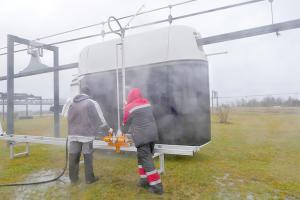The company noted that the results have confirmed sustainability of string transport to severe weather conditions.
MINSK, BELARUS, January 27, 2022 /EINPresswire.com/ -- EcoTechnoPark (Maryina Gorka, Belarus). It's pouring rain. Unibus, crossing the territory of the innovation center, confidently overcomes the dense wall of rain. If a regular passenger bus driver were in a similar situation, they
might have made a forced stop on the side of the road. But the unmanned string transport continues to move calmly, as if nothing happens.This is not a description of the cyclone that hit Belarus, but of testing of one of the Unitsky String Technologies Inc. transport. Today – in conditions of an artificially created tropical downpour. Note that in this case, it is not the ability of the electric rail vehicle to move in reduced visibility that is tested, but its water resistance.
The testers simulated a tropical downpour using a special watering machine. Last time, a similar phase of testing with the use of a sprinkler was successful. Now they decided to increase the water pressure, for which the company specially developed a new, more powerful, rainwater horizontal watering machine. Designers say that you can get caught in such a “rainstorm” only in the tropics.
While the sprinkler is being prepared for operation, Igor Cherepanov, Lead Design Engineer, tells how the drainage system functions in a unibus:
— The drainage system is located under the door and is almost invisible. A special water barrier collects water and keeps it in a way that it flows not into the passenger compartment, but through the threshold into the drain pipes and under the cabin.
The designers enter the compartment to check how it is protected from moisture. Unibus starts moving. At the same time, the watering machine also starts up – the pressure of the water is such that it is difficult to see what is going on outside the transport cabin. It seems that the passengers are genuinely happy that the reliable hull of the unibus separates them from the artificially created environment.
After some time, the “rain” ends, and the designers leave the vehicle’s compartment.
“Our expectations for the effectiveness of the drainage system are met. It’s doing its job. However, this is not the final, but a milestone test. We conduct it to understand how the system can become even better. We plan to modernize it and conduct new tests in spring”, leading design engineer Artyom Savko draws the intermediate conclusion.
As you can see, string transport is very resistant even to the most adverse weather conditions. The system responsible for water resistance has proven its effectiveness. At the same time, the situation, which could become a serious problem for any vehicle, did not affect the unibus operation in any way. This is just one of a series of tests aimed to make string transport as safe, efficient, and comfortable for passengers as possible. You can find out more in the next UST reports.


No comments:
Post a Comment